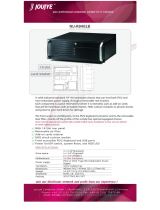Hyperthreading and Multi-Core Technology
Hyperthreading is an Intel technology that can enhance overall computer performance by allowing one physical processor to function as two logical processors
that are capable of performing certain tasks simultaneously. Multi-core processors contain two or more physical computational units inside a single CPU
package, thereby increasing computing efficiency and multi-tasking ability. Intel has implemented this technology in its Dual-Core and Quad-Core processors.
These processors have two and four computational units respectively. It is recommended that you use the Microsoft Windows XP Service Pack 1 (SP1) or
higher or Windows Vista operating systems which are optimized to take advantage of these technologies.
While many programs can benefit from hyperthreading and multi-core technology, some programs may have not been optimized for them and may require an
update from the software manufacturer. Contact the software manufacturer for updates and information about using hyperthreading or multi-core technology
with your software. To determine if your computer is using hyperthreading technology, check the system setup option for hyperthreading under the
Performance tab (see System Setup).
Power Management for Windows XP and Windows Vista
Options in Windows XP
The Microsoft Windows XP power management features can reduce the amount of electricity your computer uses when it is on and you are not using it. You
can reduce power to just the monitor or the hard drive, or you can use standby mode or hibernate mode to reduce power to the entire computer. When the
computer exits from a power conservation mode, it returns to the operating state it was in prior to entering the mode.
Standby Mode
Standby mode conserves power by turning off the display and the hard drive after a designated period of time, known as a time-out. When the computer exits
from standby mode, it returns to the operating state it was in prior to entering standby mode.
To set standby mode to automatically activate after a defined period of inactivity:
1. Click Start® Control Panel® Pick a category® Performance and Maintenance.
2. Under or pick a Control Panel icon, click Power Options.
To immediately activate standby mode without a period of inactivity, click Start® Turn Off Computer® Stand by.
To exit from standby mode, press a key on the keyboard or move the mouse.
Hibernate Mode
Hibernate mode conserves power by copying system data to a reserved area on the hard drive, and then completely turning off the computer. When the
computer exits from hibernate mode, the desktop is restored to the state it was in prior to entering hibernate mode.
To activate hibernate mode:
1. Click Start® Control Panel® Pick a category® Performance and Maintenance.
2. Under or pick a Control Panel icon, click Power Options.
3. Define your hibernate settings on the Power Schemes tab, Advanced tab, and Hibernate tab.
To exit from hibernate mode, press the power button. The computer may take a short time to exit from hibernate mode. Because the keyboard and mouse do
not function in hibernate mode, pressing a key on the keyboard or moving the mouse does not bring the computer out of hibernation.
Because hibernate mode requires a special file on your hard drive with enough disk space to store the contents of the computer memory, Dell creates an
appropriately sized hibernate mode file before shipping the computer to you. If the computer's hard drive becomes corrupted, Windows XP recreates the
hibernate file automatically.
Power Options Properties
Define your standby mode settings, hibernate mode settings, and other power settings in the Power Options Properties window. To access the Power
Options Properties window:




















